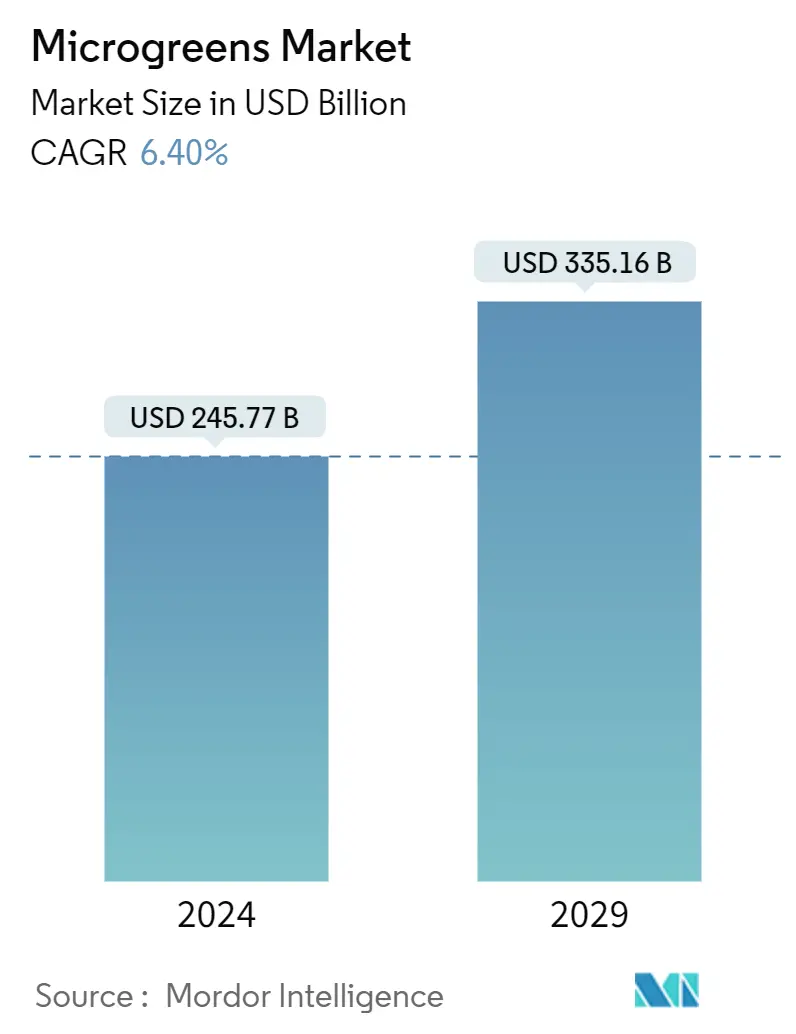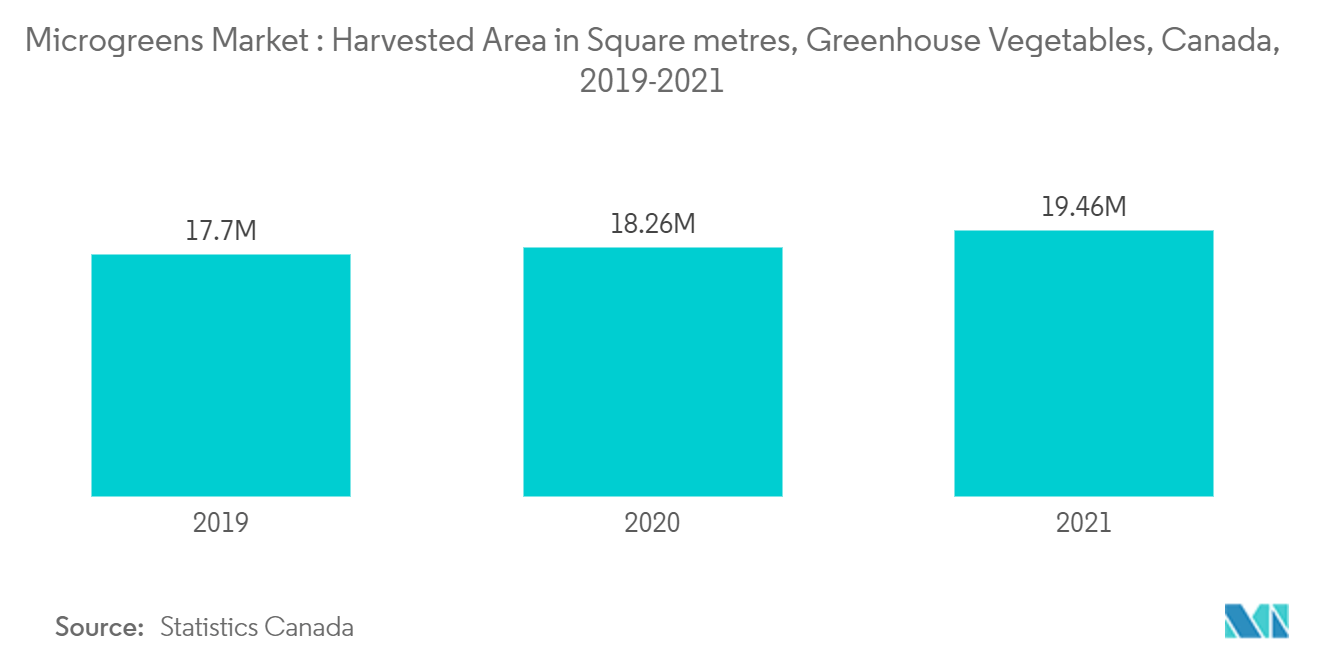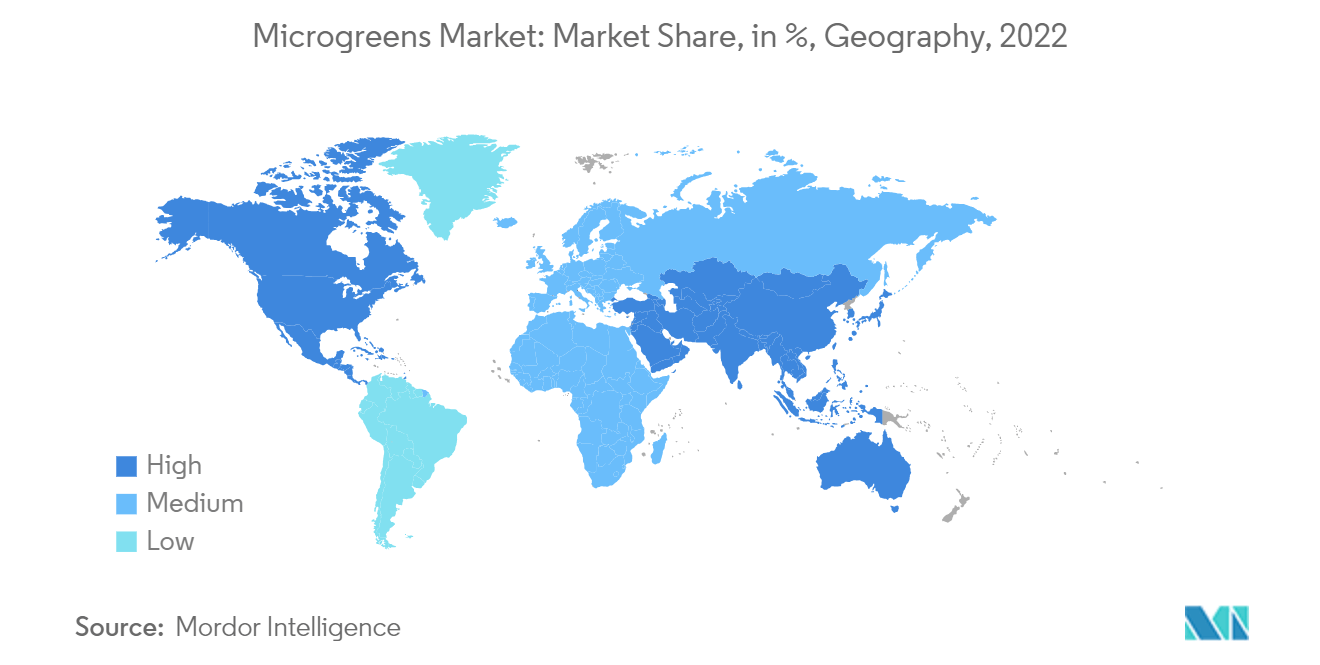Microgreens Market Size

| Study Period | 2019-2029 |
| Market Size (2024) | USD 245.77 Billion |
| Market Size (2029) | USD 335.16 Billion |
| CAGR (2024 - 2029) | 6.40 % |
| Fastest Growing Market | Asia Pacific |
| Largest Market | North America |
Major Players
*Disclaimer: Major Players sorted in no particular order |
Microgreens Market Analysis
The Microgreens Market size is estimated at USD 245.77 billion in 2024, and is expected to reach USD 335.16 billion by 2029, growing at a CAGR of 6.40% during the forecast period (2024-2029).
- Microgreens are small, tender vegetable greens commonly consumed to enhance the color, texture, and flavor of various dishes, including pasta, pizza, omelets, and salads. Their robust aromatic flavor, diverse range of colors, and textures make them popular in culinary applications. The health benefits associated with consuming microgreens include weight management, prevention of chronic medical conditions, immunity boosting, and mental health improvement.
- The market for microgreens is primarily driven by chefs who use them to elevate flavors and enhance the visual appeal of their dishes. Additionally, a niche industry contributing to growth in this segment is cosmetics. Microgreens are processed into oils and ingredients for consumer products like shampoo and skincare items due to their high content of vitamins A and B, along with various micro-elements. This factor makes them desirable components for manufacturers in the personal care product industry, leading to an expected increase in demand for microgreens over time.
- While greens and herbs or microgreens are among the most profitable crops, the limited varieties available for indoor farming might restrict market growth. Although hydroponics farming holds significant potential, its progress and adoption in agriculture have been relatively slow.
- Broccoli, lettuce, arugula, and basil are among the essential microgreens cultivated worldwide using hydroponics and vertical farming techniques. The demand for microgreens is on the rise in developed countries, as they can be cultivated indoors throughout the year. For example, according to the United States Fresh Produce Association, the likelihood of consumers purchasing broccoli microgreens increases with income and age. With a growing population, microgreens offer a nutritious and sustainable means to diversify the food supply, which is expected to drive market growth in the coming years. In 2022, North America held the largest market share, led by the United States, followed by Canada and Mexico.
Microgreens Market Trends
Rise in Adoption of Indoor Farming
- The growing population has led to increased food demand, making farmers turn towards high-tech methods like indoor farming because of the decrease in productive land. Along with this, the growing health consciousness has led people to consume a diet full of nutrients, which has led to the adoption of indoor farming practices.
- According to a survey conducted by Artemis, an intelligence platform, nearly 16% of indoor cultivators are engaged in the production of microgreens. Thus, the market for microgreens is anticipated to grow in the future.
- In addition to these factors, the increased acceptance of agricultural mechanization and advanced knowledge of high-tech farming techniques like hydroponics, aeroponics, and aquaponics is anticipated to promote the expansion of the microgreens industry. With consumers worldwide turning toward healthy diets, the demand is increasing, and microgreen production is expected to increase in the coming years. This rising adoption of protected cultivation has led the market to grow moderately.
- Furthermore, in Canada, there has been a steady increase in greenhouse vegetable production, including microgreens, and it is anticipated that the multi-decade growth trend will continue soon. Notably, in 2021, provinces like Ontario, British Columbia, and Quebec boasted the highest harvested areas of greenhouse-grown vegetables, with 1378.7, 316.8, and 151.1 hectares, respectively.
- Henceforth, the success of greenhouse technology is boosting the microgreens market. Thus, the revenue has stabilized with the growth in demand, which, in turn, has aided in the market growth.

North America is the Largest Market for Microgreens
- North America accounted for the largest share of the microgreens industry in 2022. The rise in the awareness of health benefits and balanced diets has made people in this region include green vegetable salads and organic-based food items, including microgreens, in their diets, increasing the market for microgreens. With the help of enhanced indoor and vertical farming practices, US growers have been able to produce microgreens on a large scale. For instance,
- According to Agrilyst, a prominent intelligence platform, greenhouse distribution across various areas in the United States varied considerably. Moreover, hydroponic farming has proven to be the most lucrative for Californian farmers, particularly for crops like broccoli, lettuce, and salad vegetables, which are well-suited to this farming technique.
- Many retailers provide "Certified Naturally Grown" microgreen seeds to local restaurants and farmers in the United States, which can be grown hydroponically and through vertical farming. Canadian farmers rely on indoor agriculture rather than greenhouse farming for growing microgreens because of the electricity needed for lighting. Growing indoors eliminates many of the pest and disease problems of outdoor production. Thus, farmers are tapping into this market due to the increased microgreen demand from companies globally.

Microgreens Industry Overview
The microgreens market is fragmented and highly competitive due to the presence of international and regional players. The key players in the microgreens market include Farmbox Greens LLC, The Chef’s Garden Inc., Aerofarms LLC, Living Earth Farms, and Good Leaf Farms. These players are adopting product launches and expansion as key strategies for growth in the microgreens market.
Microgreens Market Leaders
-
Farmbox Greens
-
AeroFarms
-
Chef's Garden
-
Good Leaf Farms
-
Living Earth Farms
*Disclaimer: Major Players sorted in no particular order

Microgreens Market News
- May 2023: AeroFarms, a Certified B Corporation and a prominent figure in indoor vertical farming took a significant step forward by launching a nationwide expansion through a collaboration with Amazon Fresh. This partnership aims to enhance the high-tech consumer grocery experience. Building on their prior success with Whole Foods Market in 2022, AeroFarms became the first indoor leafy greens grower to be included in Whole Foods Market's Global Planogram, setting an industry precedent.
- February 2023: Good Leaf Farm, an indoor agriculture company, joined forces with Unfold, a leading seed, and digital solutions company, to introduce premium lines of vertically farmed spinach and assorted leafy greens through Unfold's Innovation Partner Program.
- August 2022: AeroFarms significantly increased its retail presence and accessibility by extending its reach to 160 Fresh Market stores across 22 states. Customers at these stores could now enjoy AeroFarm's delectable microgreens and baby watercress.
Microgreens Market Report - Table of Contents
1. INTRODUCTION
- 1.1 Study Assumptions
- 1.2 Market Definition and Scope of the Study
2. RESEARCH METHODOLOGY
3. EXECUTIVE SUMMARY
4. MARKET DYNAMICS
- 4.1 Market Overview
- 4.2 Market Drivers
- 4.3 Market Restraints
- 4.4 Value Chain Analysis
5. MARKET SEGMENTATION
-
5.1 Type
- 5.1.1 Broccoli
- 5.1.2 Lettuce and Chicory
- 5.1.3 Arugula
- 5.1.4 Basil
- 5.1.5 Fennel
- 5.1.6 Carrots
- 5.1.7 Sunflower
- 5.1.8 Radish
- 5.1.9 Peas
- 5.1.10 Other Types
-
5.2 Farming
- 5.2.1 Indoor Farming
- 5.2.2 Vertical Farming
- 5.2.3 Commercial Greenhouses
- 5.2.4 Other Farming
-
5.3 Growth Medium
- 5.3.1 Peat Moss
- 5.3.2 Soil
- 5.3.3 Coconut Coir
- 5.3.4 Tissue Paper
- 5.3.5 Other Growth Mediums
-
5.4 Distribution Channel
- 5.4.1 Hypermarkets/Supermarkets
- 5.4.2 Restaurants
- 5.4.3 Other Distribution Channels
-
5.5 Geography
- 5.5.1 North America
- 5.5.1.1 United States
- 5.5.1.2 Canada
- 5.5.1.3 Mexico
- 5.5.1.4 Rest of North America
- 5.5.2 Europe
- 5.5.2.1 Netherlands
- 5.5.2.2 Spain
- 5.5.2.3 Germany
- 5.5.2.4 France
- 5.5.2.5 Rest of Europe
- 5.5.3 Asia-Pacific
- 5.5.3.1 China
- 5.5.3.2 India
- 5.5.3.3 Singapore
- 5.5.3.4 Australia
- 5.5.3.5 Rest of Asia-Pacific
- 5.5.4 South America
- 5.5.4.1 Brazil
- 5.5.4.2 Chile
- 5.5.4.3 Argentina
- 5.5.4.4 Rest of South America
- 5.5.5 Middle East & Africa
- 5.5.5.1 Algeria
- 5.5.5.2 Saudi Arabia
- 5.5.5.3 Egypt
- 5.5.5.4 South Africa
- 5.5.5.5 Rest of Middle East & Africa
6. COMPETITIVE LANDSCAPE
- 6.1 Most Adopted Strategies
- 6.2 Market Share Analysis
-
6.3 Company Profiles
- 6.3.1 AeroFarms LLC
- 6.3.2 Goodleaf Farms
- 6.3.3 Living Earth Farm
- 6.3.4 Farm Box Greens
- 6.3.5 Jiangsu Skyplant Greenhouse Technology Co. Ltd
- 6.3.6 Shanghai Dehuan Industry Co. Ltd
- 6.3.7 Chef's Garden Inc.
- 6.3.8 Madar Farms
- 6.3.9 Metro Microgreens
- 6.3.10 Gotham Greens
- *List Not Exhaustive
7. MARKET OPPORTUNITIES AND FUTURE TRENDS
** Subject To AvailablityMicrogreens Industry Segmentation
Microgreens are shoots of salad vegetables picked just after the first leaves have developed. They have fully grown cotyledon leaves and, usually, one pair of very small, partially produced true leaves. They are cultivated using various kinds of farming, such as vertical farming, indoor farming, and commercial greenhouses. The microgreens market is segmented by type (broccoli, lettuce and chicory, arugula, basil, fennel, carrots, sunflower, radish, peas, and other types), farming (indoor farming, vertical farming, commercial greenhouses, and other farming), growth medium (coconut coir, peat moss, soil, tissue paper, and other growth mediums), distribution channel (hypermarkets/supermarkets, restaurants, and other distribution channels), and geography (North America, Europe, Asia-Pacific, South America, and Middle East & Africa). The report offers the market size and forecasts in terms of value (USD) for the above-mentioned segments.
| Type | Broccoli | |
| Lettuce and Chicory | ||
| Arugula | ||
| Basil | ||
| Fennel | ||
| Carrots | ||
| Sunflower | ||
| Radish | ||
| Peas | ||
| Other Types | ||
| Farming | Indoor Farming | |
| Vertical Farming | ||
| Commercial Greenhouses | ||
| Other Farming | ||
| Growth Medium | Peat Moss | |
| Soil | ||
| Coconut Coir | ||
| Tissue Paper | ||
| Other Growth Mediums | ||
| Distribution Channel | Hypermarkets/Supermarkets | |
| Restaurants | ||
| Other Distribution Channels | ||
| Geography | North America | United States |
| Canada | ||
| Mexico | ||
| Rest of North America | ||
| Geography | Europe | Netherlands |
| Spain | ||
| Germany | ||
| France | ||
| Rest of Europe | ||
| Geography | Asia-Pacific | China |
| India | ||
| Singapore | ||
| Australia | ||
| Rest of Asia-Pacific | ||
| Geography | South America | Brazil |
| Chile | ||
| Argentina | ||
| Rest of South America | ||
| Geography | Middle East & Africa | Algeria |
| Saudi Arabia | ||
| Egypt | ||
| South Africa | ||
| Rest of Middle East & Africa |
Microgreens Market Research Faqs
How big is the Microgreens Market?
The Microgreens Market size is expected to reach USD 245.77 billion in 2024 and grow at a CAGR of 6.40% to reach USD 335.16 billion by 2029.
What is the current Microgreens Market size?
In 2024, the Microgreens Market size is expected to reach USD 245.77 billion.
Who are the key players in Microgreens Market?
Farmbox Greens, AeroFarms, Chef's Garden, Good Leaf Farms and Living Earth Farms are the major companies operating in the Microgreens Market.
Which is the fastest growing region in Microgreens Market?
Asia Pacific is estimated to grow at the highest CAGR over the forecast period (2024-2029).
Which region has the biggest share in Microgreens Market?
In 2024, the North America accounts for the largest market share in Microgreens Market.
What years does this Microgreens Market cover, and what was the market size in 2023?
In 2023, the Microgreens Market size was estimated at USD 230.04 billion. The report covers the Microgreens Market historical market size for years: 2019, 2020, 2021, 2022 and 2023. The report also forecasts the Microgreens Market size for years: 2024, 2025, 2026, 2027, 2028 and 2029.
What are the challenges faced by new entrants in the Microgreens Market?
The challenges faced by new entrants in the Microgreens Market are a) Competition b) Establishing consistent supply chains c) Consumer awareness
Microgreens Industry Report
The global microgreens market is experiencing significant growth, driven by a surge in consumer health consciousness and demand for nutrient-rich, fast-growing greens. Favored for both residential and commercial purposes, microgreens thrive in controlled environments like indoor vertical farms and commercial greenhouses. The market diversification includes various types, such as broccoli, arugula, radish, and basil, each chosen for their unique health benefits and cultivation ease. These greens are available through various distribution channels, including retail stores, online platforms, farmers markets, and supermarkets/hypermarkets, and are popular in culinary settings as garnishes and flavor enhancers. Regionally, North America leads due to advanced farming technologies and high health food expenditure, with Europe and Asia-Pacific also showing promising growth through sustainable farming practices. The expansion in the microgreens market reflects broader consumer trends towards health-focused diets and sustainable food production, supported by continual innovations in farming methods and product offerings. For in-depth analysis and market forecasts, a report by Mordor Intelligence™ offers a detailed overview. Get a sample of this industry analysis as a free report PDF download.



